A master teaching beginners – waste of time or enrichment?
Again and again I hear highly graded teachers say “I don’t teach student grades, I don’t find it interesting.“ This point of view is understandable. It can certainly be tedious to explain the same things over and over again – having to start from scratch, so to speak.
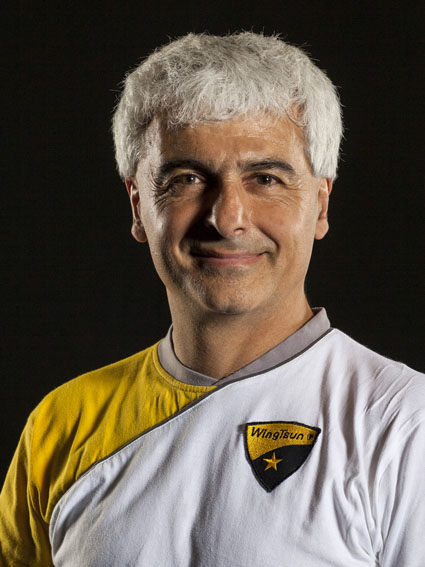 Collecting and motivating
Collecting and motivating
Speaking for myself, I really enjoy it. I am always very pleased if I am able to light a fire for WingTsun in a beginner:
- Students can become very enthusiastic when they start, and as a teacher, I am always delighted to see such enthusiasm. I am pleased that the student is pleased.
- During this learning stage you see the progress very directly. It comes in large, obvious stages, and the students work hard.
- Beginners always ask challenging questions such as Why is this movement done in precisely that way? How can I manage to …? As the teacher I have to think very carefully about my answers, and this automatically improves my own understanding.
There are a few aspects to note when teaching beginners, so that both the teacher and the students benefit:
- It is important to collect students from where they actually are
If the teacher expects more than the student can give, the student feels overloaded. This can lead to someone in the early learning stages thinking that WingTsun is too difficult. The urge to learn fades away, and the student possibly gives up WingTsun classes altogether.
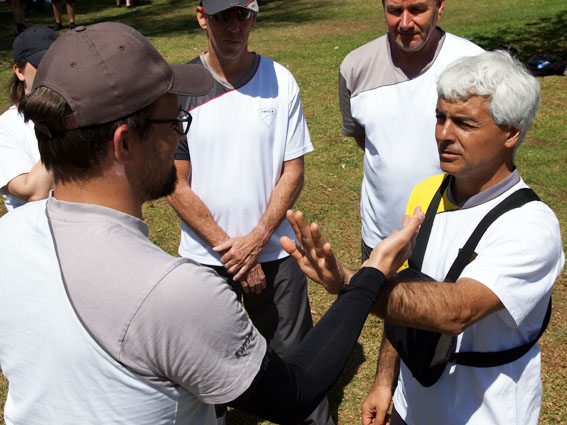 The goal must be recognisable
The goal must be recognisable
The students must be able to see how things fit together: Why do I have to practice this? Where will it get me? What is the medium-term goal I’m working towards?
- Set small, intermediate goals
One frequent mistake is to show too much all at once. This only leads to disappointment – among the students because they are unable to implement it, and in the teacher because the students don’t seem to have ”got it”. But repeatedly achieving minor goals is enormously motivating.
- Praise is important
Achieving intermediate goals should be confirmed and praised. The teacher recognises the student’s learning progress and makes the hard work worthwhile – in addition to the actual improvement.
- Please don’t over-correct
No question, especially with beginners, we see many things that could be done better. Nonetheless, it is important to stick with the point of the exercise when correcting students.
For example: if the student is practicing the punch, you should only correct the movements of the arm and fist, not something else. “Your punch has improved now, but your feet are in the wrong position,“ is simply a turn-off.
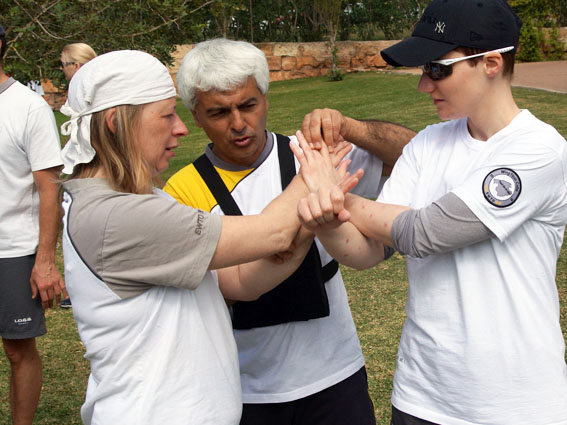 No premature corrections
No premature corrections
Only correct students when they have had a chance to practice for a while. Nothing is more frustrating than being corrected before you have had time to try things out.
- Give explanations and propose solutions
Merely saying “That’s wrong!“ with no further explanation makes students unsure and demotivates. Accordingly, our new student is likely to look for another spare-time occupation. If you give an explanation, and if possible guidance on how to do it better, things will progress again.
Trying out, experimenting and finding
Learning movements means trying out, experimenting and finding out what doesn’t work – until it works. In short, it takes time. Think back to your own beginnings in WingTsun: how were you treated when you were stuck in that learning phase? No doubt you will be more willing to give others the chance to learn and make mistakes.
Especially in the case of students who are slower to learn or find things difficult, a great deal of patience is required to gain the confidence that ”I can get there too!“. Applying pressure would be quite wrong.
Although we teach self-defence, our classes are not acute threat situations. The student is giving us his/her free time, and wants to learn something useful in a pleasant atmosphere and meet nice people.
Varying the teaching content
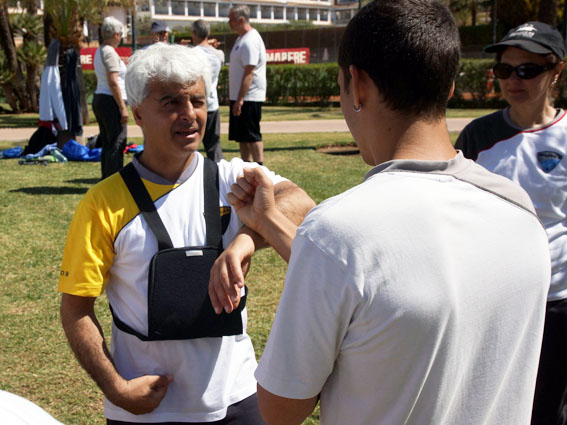 I have been teaching since I obtained my 3rd student grade, and I have learned a great deal from it – at all levels. I have repeatedly noticed that there is a great deal of knowledge contained in the lower student grades. I have understood many things more clearly by examining and going through them in detail with students. I have recognised that the innocuous and unspectacular often contains much that is important.
I have been teaching since I obtained my 3rd student grade, and I have learned a great deal from it – at all levels. I have repeatedly noticed that there is a great deal of knowledge contained in the lower student grades. I have understood many things more clearly by examining and going through them in detail with students. I have recognised that the innocuous and unspectacular often contains much that is important.
The people who take part in our courses can be very different. Each one learns differently or has other physical attributes. Our aim is to make sure that each one arrives at his/her goal and understands WingTsun a little better. The teaching methods should therefore be varied so that everyone has a chance. The better the students understand what is important, they more motivated they will be.
For over a year, we have been able to adopt the esa learning methods for adult sports formulated by the Ministry of Sport (a national educational scheme for instructors in various sporting disciplines) for our WingTsun in Switzerland. This is based precisely on the understanding that adults wish to be taught with enthusiasm, fun and variety. To achieve learning efficiency, the principle employed is “advising“ rather than “correcting“, i.e. teaching as an advisory exchange at eye-level, and not top-down. While this is not the traditional Chinese way of teaching, it works much better for Europeans.
Teaching methods
1. Demonstration and imitation
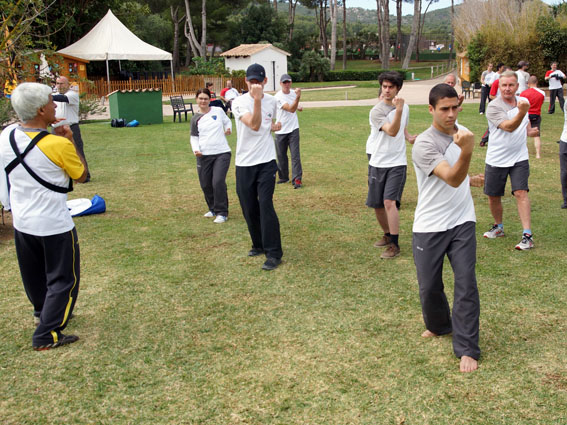 The instructor shows the movement and gives verbal instructions. This is our most frequent form of teaching.
The instructor shows the movement and gives verbal instructions. This is our most frequent form of teaching.
People are used to imitating something, copying something they have seen as well as possible.
In this case it is of course important for the instructor to show the movement correctly, and to know precisely how it proceeds. Students imitate things very precisely – including the incorrect movements. Regular self-monitoring using a mirror, video or by checking with your own teacher is therefore important.
Make sure that
- the students can see you clearly (smaller ones to the front)
- you only mention the most important aspects, depending on the level
- you show individual parts so that the students are better able to absorb them
- you demonstrate (visually), explain (verbally) and perform the movement (sensory), as every student learns differently
- you impart additional knowledge.
For example, correct breathing, where your centre of gravity is, how to keep your balance, how to improve the seven big capabilities, or what the biomechanical processes are.
2. Getting together to examine single topics
Working in groups also works well in our classes. Here are a few ideas and possibilities:
- Shared task
Groups of two, three or more students are given the task to perform a certain exercise and help each other. A good approach is to give each partner the task of explaining the exercise to the others. This requires quite a bit of thought, and the students are far more concentrated.
- Role-changing
One student is given the role of instructor and asked to judge a sequence in the form. The roles are then exchanged. The teacher observes the whole thing and afterwards obtains feedback on what was recognised and learned.
- Individual tasks
Resolving a task together. The teacher e.g. sets out a certain self-defence situation. Together or in small groups, the students are asked to come up with a solution according to their current level of knowledge. The teacher stays there and gives assistance if required. At the end the different strategies are examined, and their advantages and disadvantages discussed.
“Tell me about it – and I will forget.
Show me it – and I will remember.
Let me do it – and I will absorb it.“
So try it out and have fun! I’m happy to answer any questions you may have.
Your Giuseppe Schembri
Photos: hm


